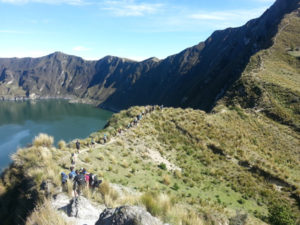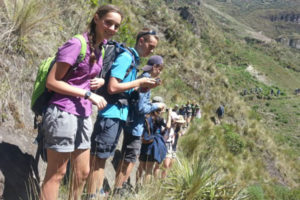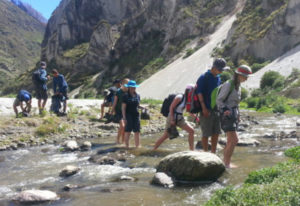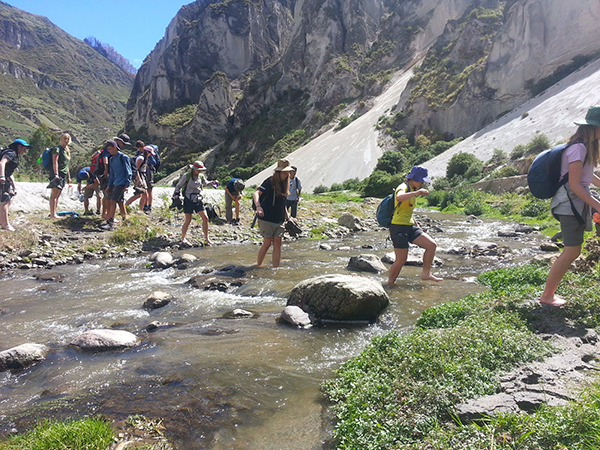- Overview
- Trip Outline
- Trip Includes
- Trip Excludes
- Gallery
- Booking
- FAQ
With this option you begin your trek in Isinlivi and hike up the valley towards Laguna Quilotoa. This is mostly uphill and can be quite challenging if you are not fit or familiar with multi day hikes. If you’re looking for an easier option we can also offer the mostly downhill, Quilotoa to Isinlivi trek. The Quilotoa Loop (12,631ft / 3,850 m) is reached by one of the most beautiful routes connecting the highlands with the coast. This volcanic crater is filled with a beautiful emerald lake. As we hike towards the lagoon, we pass through the indigenous villages of the area which provide a fantastic chance to see the true Ecuador.
No details found.
Itineraries
Day 1
Hike around the Isinlivi village
We’ll leave from Quito (9,186 ft / 2,800 m) in the morning and will drive to the Quilotoa Lagoon. During the tour we will stop at an Indian hut and visit the Tigua community to observe the leather crafts made here. The tour will take us about 4 hours, after which we’ll arrive at the viewpoint and observe the magnitude of the crater and its lagoon.
We will then descend along varying terrains; the walk will take us an hour until we arrive at the bottom of the lagoon to take photos, have lunch and rest.
Included meals: Breakfast, box lunch, dinner
Accommodation: Quilotoa Shalala
Day 2
Hike from Isinlivi to the Chugchilán village
Hiking from Laguna Quilotoa to Chugchilán we will have beautiful views of the Toachi River Canyon. First we will walk along the crater edge with impressive views of the lagoon inside, and then descend to the plateau of the small indigenous village Huayama. As we descend the switch back trails down to the Toachi River Gorge, the climate and scenery change dramatically. Soon we will be surrounded by the canyon walls and hike along the river banks. The hike ranges from 4 to 5 hours and is moderately challenging. We will be staying at the Cloud Forest Hostal. It is a basic, but a friendly and clean hostel run by José Luis. Chugchilán is a well known destination for hikers and a typical mountain region village in Ecuador. It has a small plaza, a church and a school, and most of the people still use a horse or donkey as transport. Here you will feel like you have gone back a few hundred years in time. (B;LB;D)
Included meals: Breakfast, box lunch, dinner
Accommodation: Cloud Forest Hostal
Day 3
Hike from Chugchilan to the Wonderful Lake Quilotoa
Hike from Chugchilan to Isinlivi. This hike follows the Toachi canyon and you will hike a great part along the river and pass through small highland villages. The hike ranges from 4 to 5 hours and is moderately challenging. After lunch we will drive back to the village of El Chaupi where we will have a coffee before going back to Quito.
Included meals: Breakfast, boxed lunch
- Hotel pickup and drop-off
- Professional local guide
- All meals during the hikes (see itinerary)
- Saquisilí indigenous market (only thursday)
- Our Accommodation is in hostels but you can ask for the prices of the Hosterías or Lodges
- Tigua community painting gallery
- International flights
- Any kind of insurance
- Accommodation and meals while in Quito
- Alcoholic drinks (available to purchase)
- Lunch
- Tips
- Mule ride (USD 10.00, subject to change)
- Kayak rental (USD 4.00, subject to change)
- Other non-specified expenses
We kindly refer to our Terms & Conditions page which can be found in the footer of our website.
In Ecuador you can hike all year, but these are the seasons:
- High Season: June to August / December to January
- Low season: February to May / September to November
You should be in good physical condition and it is highly recommended that they have some backpacking experience.
We recommend you bring:
- A comfortable backpack (take into account everything you have to load)
- Warm and comfortable clothing
- Warm hat and gloves
- Extra gloves (recommended)
- A spare pair of light shoes for in the refuge
- Waterproof jacket or poncho
- Trekking poles
- Hat, sunglasses and sunscreen
- Water bottle or Camelbak hydration system
- Headlamp
- Warm clothes for the refuge (protected in waterproof bags)
- Grooming Kit
- Clothes to leave on the bus








